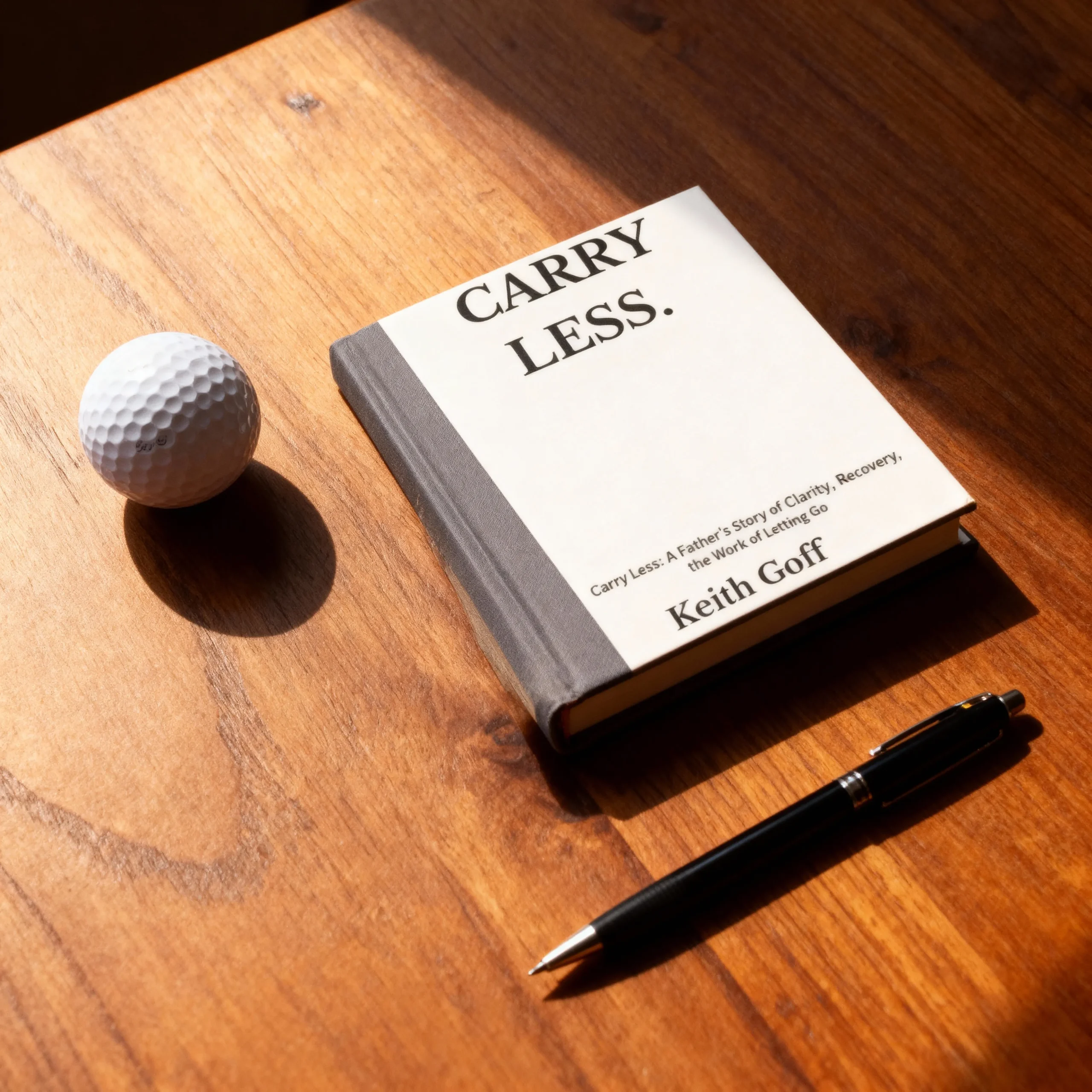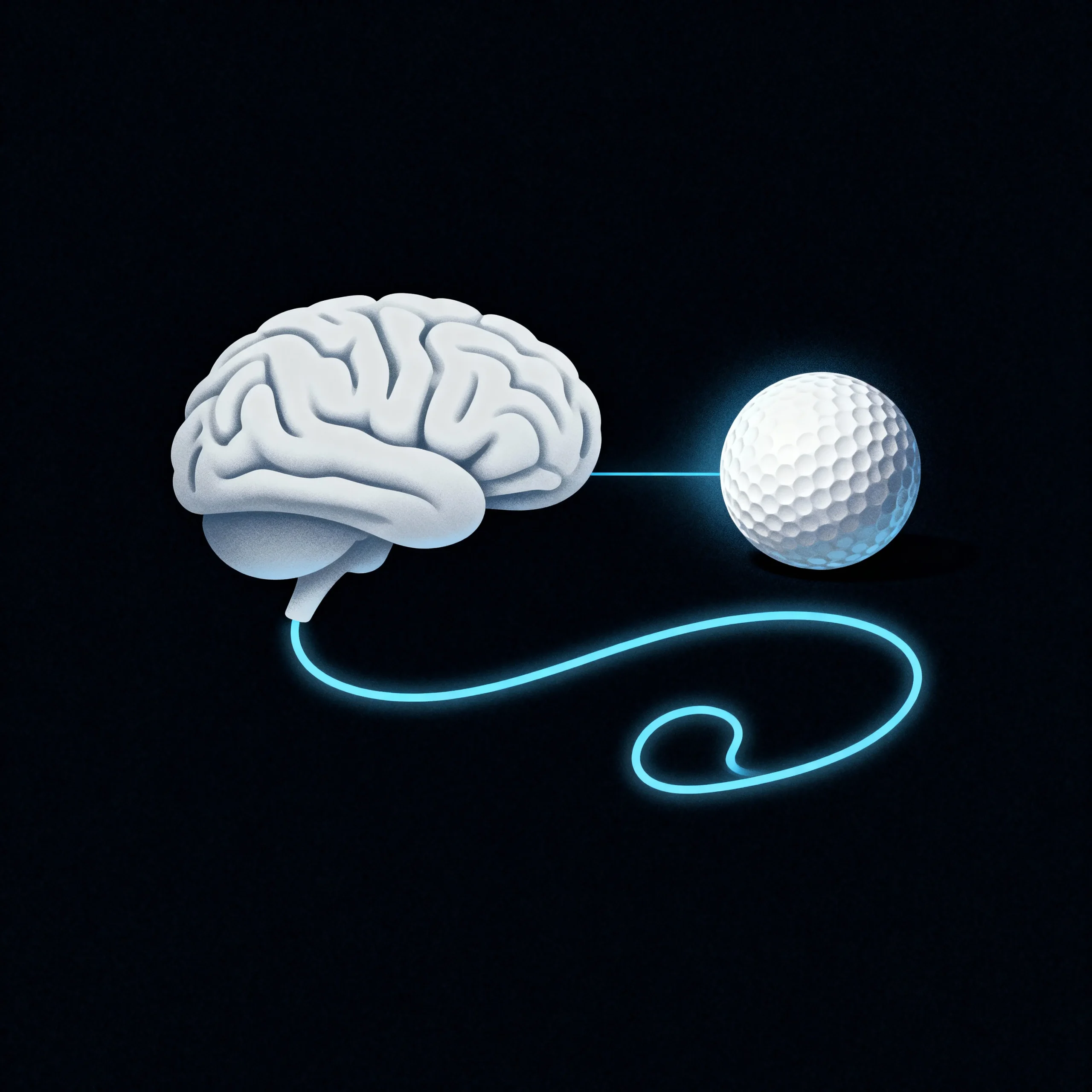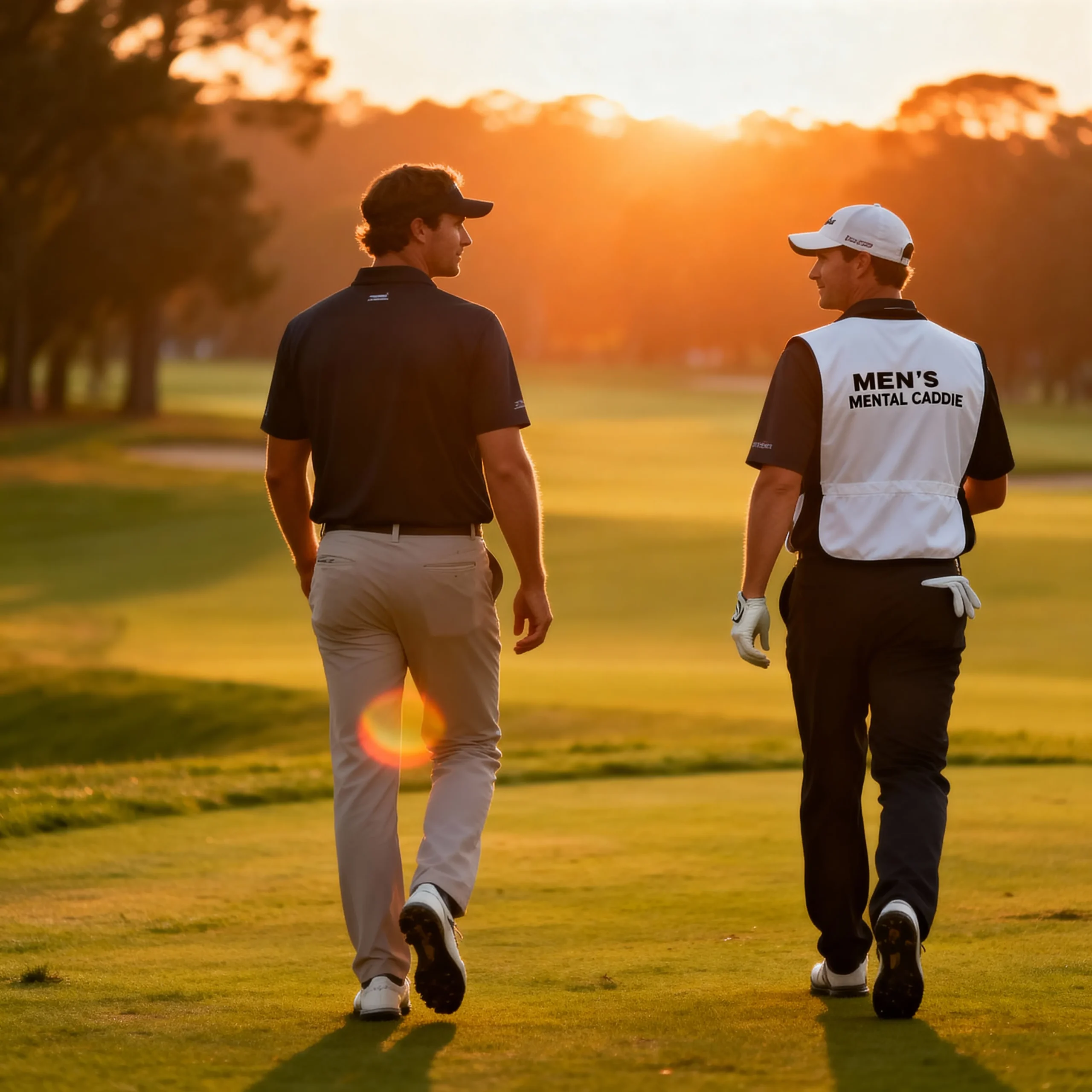The Weight You Carry Between Shots: Why Writing Your Story Helps You Carry Less
For the men who look steady on the outside and carry quiet weight between shots. This is why men hide their stories, and how writing your own story can help you carry less and live steady.

The sun had not cleared the tree line when I sat down at the kitchen table with a worn copy of Jack’s Course. The house was quiet. Just me, black coffee cooling in the cup, and the pages I had written years earlier about a life I spent decades trying to outrun.
I did not know what I expected to feel reading it again. Maybe pride. Maybe distance. What I found instead was the man I used to be staring back at me through every paragraph.
The father who wanted his kids to know the truth. The man who finally stopped pretending he had it all figured out. The golfer who realized the heaviest thing in his bag was not the clubs.
That morning I understood something I could not see when I first put those words on paper. Writing the story did more than help me remember. It changed the weight of what I was carrying.
The Men Who Look Steady But Feel Restless
You know the type because you might be him. Solid career. Good family. Decent handicap. From the outside, everything looks dialed in.
Inside there is a low hum of restlessness that does not quit. A sense that you built something strong and still cannot settle into it.
You have survived a lot and you still do not feel steady.
If control worked, you would feel calm by now. You have done everything right. Checked boxes. Managed variables. Optimized your approach. But somewhere between the fairway and the green, the pressure builds again.
It is not a discipline problem. It is not weakness. It is the weight of stories you never named. Patterns you never wrote down. Pressure you learned to hide so well you forgot it was there. This is why men hide their stories. Not because they are cowards, but because no one taught them a better way to carry the load.

Golf shows you this in quiet ways. The tension in your grip before a critical putt. The breath you hold standing over the ball. The way one bad shot can spiral into a bad hole, then a bad nine, then a round you would rather forget.
Presence should feel natural but often does not. Expectation sits on your shoulders like an invisible weight. Silence becomes the place where everything you are not saying gets louder.
And the lie beneath the ball. It is never just about the turf.
Why I Wrote Jack’s Course First
I did not write Jack’s Course because I wanted to be an author. I wrote it because I was a father who could not shake the feeling that my kids deserved the truth.
Not the polished version. Not the story where Dad had it all together. The real one. The early years. The addiction. The fear. The years I spent building walls so high I could not see over them myself.
It became a record of what it took to rebuild after everything fell apart. The turning points that mattered. The people who stayed. The moments I wanted to quit but did not.
I wrote it so my kids would know their father as a man, not just a role. So they would understand that strength is not the absence of struggle. Strength is what you do in the middle of it.
Looking back, I see what I could not see then. Writing that book was not only for them. It was the first time I stopped running from my own story.

If you want to see where this began, you can explore all of my books on Amazon. Each one is a different chapter of the same truth.
Years Later: Why I Wrote Carry Less
Carry Less came later. Not as a sequel. As a revelation.
By the time I sat down to write it, I had been in recovery for years. I had rebuilt my life. I had work I believed in, relationships that mattered, routines that kept me grounded.
But I was still heavy.
Not from what I had lost. From what I was still holding. Old patterns I could not name. Survival habits that once protected me and now kept me from breathing.
I did not write Carry Less to present myself as wise. I wrote it because I finally stopped pretending I did not need help. I stopped hiding the parts of my story that still had a grip on me.
This book was different. It was not about where I had been. It was about recognizing that you can survive everything and still not know how to rest. You can build a good life and still feel one bad decision away from losing it.
You can be the man everyone depends on and still not trust yourself when the pressure is on.
Writing it forced me to look at my story not as something behind me but as something I was still living. Not as history, but as a mirror. In that mirror, I saw a pattern I had been repeating for decades.
The weight was not in the story itself. The weight lived in never saying it out loud.

Why Men Hide Their Stories And Why It Costs Them
Men are trained early to hide their stories. To keep the hard chapters locked away. To protect everyone else from the truth of what they have seen, done, and survived.
We call it being strong. We call it being steady. Underneath, it is often fear. Fear of judgment. Fear of being misunderstood. Fear that if people knew the full story, they would see a different man.
The cost is quiet and brutal. Hidden stress. Sleepless nights. A life that looks good and feels brittle. You carry the weight alone and wonder why you cannot find calm.
When men hide their stories, they also hide their path forward. You cannot adjust a shot you refuse to look at. You cannot learn from a round you never review. This is why men hide their stories and why they stay stuck.
Writing your story is not about becoming a writer. It is about seeing the truth clearly enough to choose a different shot.
The Science Behind Why This Works
Your brain does not distinguish between a memory you have processed and one you have buried. Both take up space. Both demand energy. Only one lets you move forward.

Expressive writing research from Dr. James Pennebaker and others shows that when people write about difficult experiences, their physical health improves. Blood pressure drops. Immune function strengthens. Sleep gets better. The body releases what the mind has been holding.
Studies on emotional expression reveal that men who are aware of their internal stress but have never named it gain the most from putting it into words. Writing creates cognitive space. It reorganizes how trauma sits in your brain.
Think about it this way. When you tell your story, you are not reliving it. You are reframing it. You are taking the weight you have been carrying and setting it down long enough to see it clearly.
Research published in Psychological Science confirms that translating emotional experience into language changes how it is stored. You stop cycling. You start processing. Processing is what allows you to move.
Meaning making through storytelling does more than reduce symptoms. It shifts identity. When a man sees his story honestly, he stops being defined by what happened to him and becomes the author of what happens next.
Evidence for narrative approaches shows that men who name the patterns they have been living gain agency over those patterns. They stop reacting. They start choosing. Choice is where power lives.
Narrative tools for trauma help men separate themselves from the shame they have been carrying. The story becomes something you went through, not something you are. That distinction changes everything.
For high performing men, integrating storytelling into care builds resilience at the identity level. It is not about feeling better for a week. It is about becoming someone who can handle what comes next.
Clinical evidence confirms that when men rewrite the narrative they have been living, their stress response changes. They become more adaptive. More present. Less reactive.
This is not soft talk. This is how the brain works. You cannot outwork what you refuse to name. When you name it, you stop carrying it alone.
How This Became Men’s Mental Caddie
Writing those books showed me something I could not unsee. Men do not need more motivation. They need clarity. They do not need someone to hype them up. They need someone to help them see what they have been carrying and show them how to set it down.
That is why I built Men’s Mental Caddie.
It is not coaching in the usual sense. It is not therapy. It is not a program full of slogans. It is forward focused caddie work built around one question. What is your next shot.
Not your five year plan. Not your life purpose. Your next shot. The one thing you can do in the next seven days that moves you from where you are to where you need to be.
This is the structure. Identity. Clarity. Shot. Follow through. Brotherhood.
We start with who you are right now. Not who you were. Not who you think you should be. Who you are when the noise quiets down.
Then we get clear. What are you carrying that is not yours. What patterns are you repeating that used to serve you and no longer do. What is the gap between how you look and how you feel.
From there, we identify the shot. One clear priority. One honest move. Something concrete you can take in the next week that changes your trajectory.
Follow through is where most men lose it. Not because they lack discipline, but because they lack rhythm. We build a cadence you can trust when life gets loud.
Brotherhood is the part most men do not know they need until they have it. A group of men who get it. Men who have lived it. Men who are not trying to fix you or impress you. Just walking the same course.

You can learn more about the full approach at About Men’s Mental Caddie. It is quiet work. Honest direction. No hype. Just the next right step.
The One Clear Result When You Work With Me
Here is what you get when you sit down for a Men’s Mental Caddie session. Not wishful thinking. Concrete outcomes.
You leave with one honest picture of where you actually are. Not where you wish you were. Not where you used to be. Where your feet are standing right now. That clarity is the foundation.
You leave with three clear priorities. Not a long list of fixes. Three areas that matter most. The places where your energy will create the most movement. The leverage points in your life that, if you shift them, shift everything.
Then you leave with one next shot you will take in the next seven days. Not someday. This week. One move that is concrete, doable, and meaningful.
You also walk away with a rhythm you can trust when life gets loud. Because life will get loud. Pressure will build. Chaos will show up. When it does, you will have a process that holds steady even when you do not.
This is not inspiration. This is structure. Structure is what high performing men need when everything else feels uncertain.
You do not leave pumped up. You leave clear. Clarity is what changes the game.
The Walk Between Shots
Golf teaches you that the walk between shots matters more than the swing itself. That is where the round is won or lost. In the space between swings.
Most men rush that space in life. They sprint from decision to decision. They try to control the next outcome before they have processed the last one. They carry the weight of every bad shot, every missed opportunity, every expectation they never asked for.
The best rounds, the ones you remember, happen when you learn to walk that space differently. When you stop dragging the past behind you and start trusting what is in front of you.
The lie beneath the ball tells you what you need to know. Not just about the turf. About where you are standing. About what you are bringing into this moment from every moment before it.
Presence is not something you force. Presence is something you clear space for. You clear space by naming what is in the way.
The pause before a swing is not hesitation. It is the moment you decide whether you are going to react or respond. Whether you are going to carry the weight or set it down.
Control is what you think you need. Presence is what actually works.

The Fairway at Dawn
I think about that morning at the kitchen table more than I expected. The worn pages. The cooling coffee. The man I used to be looking back at me through the words I had written.
What I did not know then was that writing the story was just the beginning. Telling it was what changed the weight of it.
You do not have to write a book. You do not have to share it with the world. But you do have to stop pretending the weight is not there.
Maybe it is the story of how you built your life. Maybe it is the pattern you keep repeating. Maybe it is the expectation you have carried since you were young that was never yours to carry in the first place.
Whatever it is, it is taking up space. That space is keeping you from the steadiness you keep looking for.
You do not have to carry it alone. You were never meant to.
Clarity comes from honesty, not effort. Honesty starts when you stop running from your own story.

Begin Here
If any of this landed, you do not need to figure everything out today. You just need to take the next step.
Start with Men’s Mental Caddie. One session. One honest conversation. One clear shot.
Or pick up one of my books on Amazon and see if the story I am telling mirrors the one you are living.
If you want a clear on ramp from this article, you can also read Stop Digging: The Weight a Man Chooses to Carry or explore more Field Notes. Each one is a quiet cue to help you see your next shot.
Carry less. Live steady.
